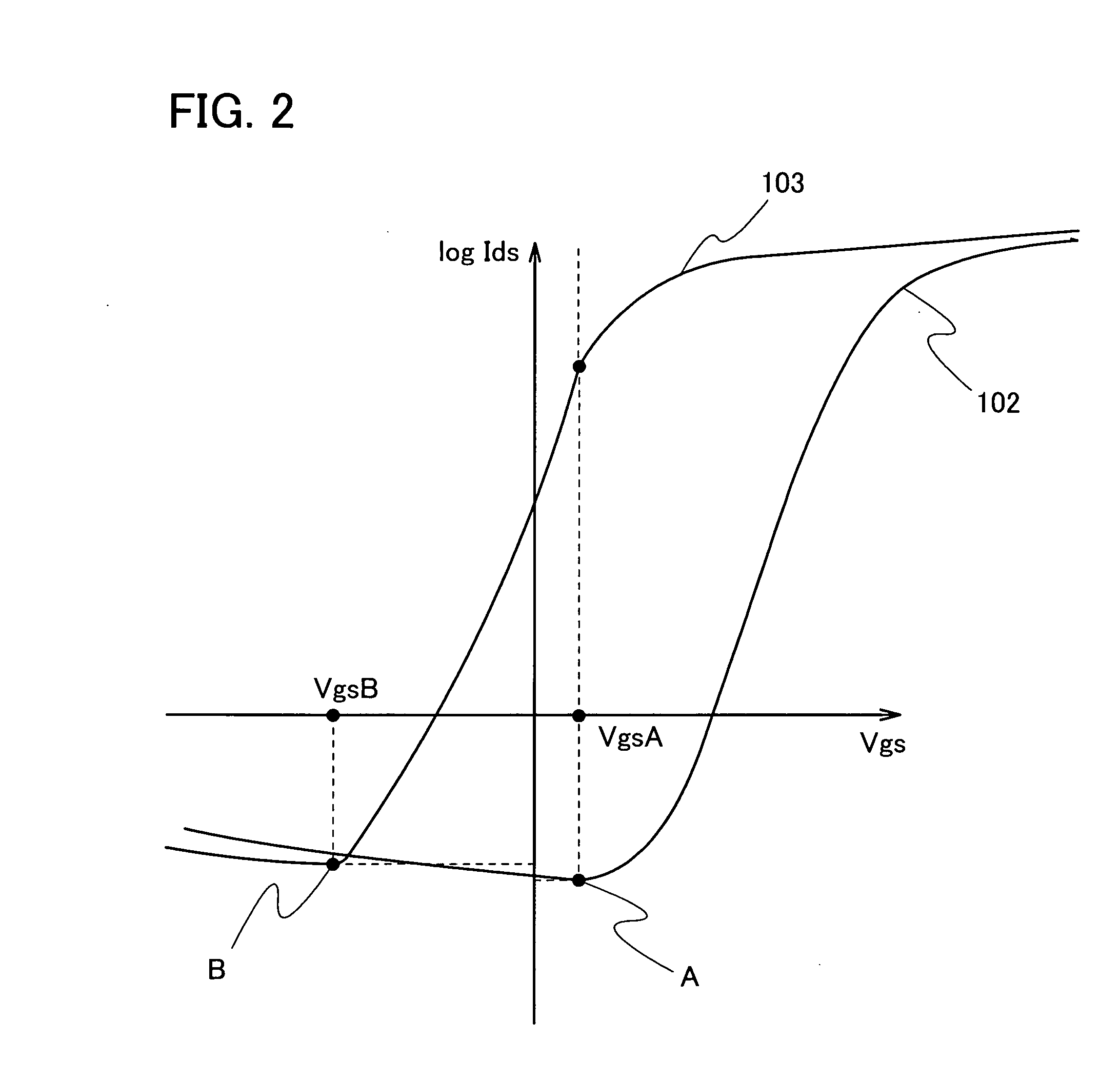Semiconductor device and electronic device using the same
- Summary
- Abstract
- Description
- Claims
- Application Information
AI Technical Summary
Benefits of technology
Problems solved by technology
Method used
Image
Examples
embodiment mode 2
[0149]The case where the first circuit 102 is a diode-connected N-channel transistor is described in Embodiment Mode 1. Note that the present invention is not limited to this, and various structures can be used for the first circuit 102. For example, as shown in FIG. 3, a current-voltage conversion circuit 102A may be used for the first circuit 102.
[0150]Connection relationships of the case where a photodiode is used as an example of the photoelectric conversion element 101 are described below. In FIG. 3, a cathode terminal of the photodiode is connected to the first terminal 104 and an anode terminal of the photodiode is connected to a first terminal of the current-voltage conversion circuit 102A. The first terminal of the current-voltage conversion circuit 102A is connected to the gate (or the gate electrode) of the N-channel transistor included in the second circuit 103. A second terminal of the current-voltage conversion circuit 102A is connected to the second terminal 105.
[0151...
embodiment mode 3
[0167]The case where output current increases as intensity of light emitted to the photoelectric conversion element 101 increases is shown in Embodiment Modes 1 and 2. In this embodiment mode, the case where output current decreases as intensity of light emitted to the photoelectric conversion element 101 increases is shown.
[0168]FIG. 8 shows a diagram of this embodiment mode which corresponds to FIG. 1A. In FIG. 8, a connection between the photoelectric conversion element 101 and an N-channel transistor included in a first circuit 802 is different from that of FIG. 1A.
[0169]A semiconductor device shown in FIG. 8 includes the photoelectric conversion element 101, a first circuit 802, a second circuit 803, the first terminal 104, and the second terminal 105. The first circuit 802 is connected to the photoelectric conversion element 101 in series. In addition, the first circuit 802 has a function of generating voltage in accordance with input current, e.g., current flowing to the phot...
embodiment mode 4
[0190]In Embodiment Mode 2, the case where various structures are used for the first circuit 102 in Embodiment Mode 1 is described. Meanwhile, in Embodiment Mode 3, the case where a connection between the first circuit 102 and the photoelectric conversion element 101 is different from that of Embodiment Mode 1 is described. Thus, the case where various structures are used for the first circuit 802 in Embodiment Mode 3 is also described in this embodiment mode.
[0191]Connection relationships of the case where a photodiode is used as an example of the photoelectric conversion element 101 are described below. In FIG. 9, a cathode terminal of the photodiode is connected to a first terminal of a current-voltage conversion circuit 802A and an anode terminal of the photodiode is connected to the second terminal 105. The first terminal of the current-voltage conversion circuit 802A is connected to the gate (or the gate electrode) of the N-channel transistor included in the second circuit 803...
PUM
 Login to View More
Login to View More Abstract
Description
Claims
Application Information
 Login to View More
Login to View More - R&D
- Intellectual Property
- Life Sciences
- Materials
- Tech Scout
- Unparalleled Data Quality
- Higher Quality Content
- 60% Fewer Hallucinations
Browse by: Latest US Patents, China's latest patents, Technical Efficacy Thesaurus, Application Domain, Technology Topic, Popular Technical Reports.
© 2025 PatSnap. All rights reserved.Legal|Privacy policy|Modern Slavery Act Transparency Statement|Sitemap|About US| Contact US: help@patsnap.com



